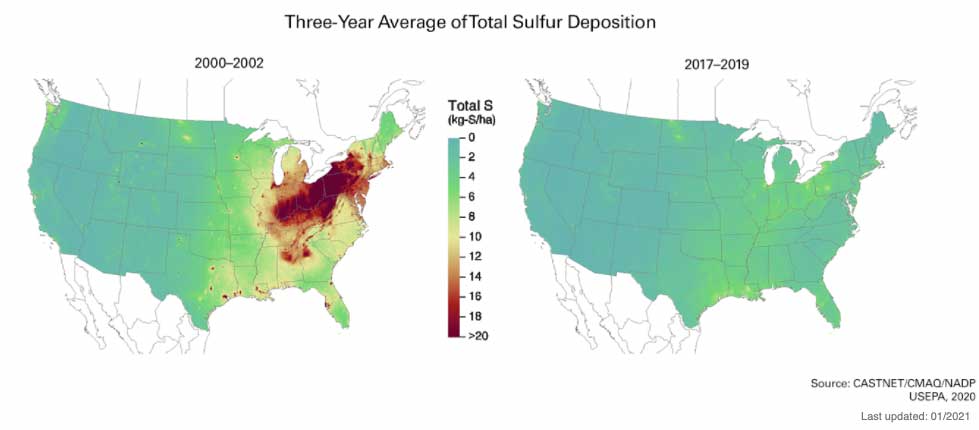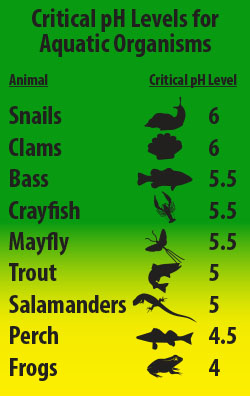Acid Rain - a success story

In the U.S. we had a serious problem with "Acid Rain" by the early 90s.
But by the mid 2010s the problem seems to have been resolved.
What happened?
Preparation assignment
Acid Rain - According to the map above acid rain was a bigger problem in the eastern US than in the west. As you read, try to formulate some guesses about why that is.
Using the EPA's site on acid rain, and / or other useful sites that you find, look for answers to these background questions about acid rain.
Acids include vinegar, lemon juice, and $H_2SO_4$ (sulfuric acid).
Bases include ammonia, drain cleaner, and $NaOH$ (sodium hydroxide).
- What are the pollutants that cause acid rain?
Sulfur dioxide ($SO_2$) and nitrogen oxides($NO_x$)
- What are the major sources of those pollutants?
Burning of fossil fuels, vehicles and heavy equipment, manufacturing, oil refineries.
Two thirds of SO2 and one fourth of NOX in the atmosphere come from electric power generators.
- What are the environmental effects of acid rain?
Acidic rain causes aluminum to come out of the soil.
High levels of Al in ponds are hazardous to fish + animals.
Acid rain also removes minerals and nutrients from the soil that are essential for [plant] growth.
- How are the effects of acid rain measured? You should discuss what "pH" is, and what values are normal or problematic.
Acid rain is measured by the pH scale which determines if a substance is acidic, neutral, or alkaline. [...] Acids have a pH reading of less than 7 and alkalines have a pH reading of more than 7
Look up the pH of...
- Human blood
- saliva
- urine
- stomach acid
Normal rain has a pH of about 5.6, which is slightly acidic because carbon dioxide dissolves into it forming a weak acid. Acid rain typically has a pH between 4.3 and 4.4.
If the ph is lower than 4, it causes fish's eggs not to hatch and die because the fish cannot handle the acidity.
 see https://www.psu.edu/news/research/story/acid-frogs/
see https://www.psu.edu/news/research/story/acid-frogs/
Some of you cited hazards to fish at pH 5 and below.
The next assignment in this sequence is due Sunday night, but you can get started on it already if you like:
"Cap and Trade cured acid rain" feedback
Imagine yourself in 1995 as the owner of coal-fired electric power plant. In 1994 your plant emitted 14,000 tons of sulfur-dioxide (SO_2\)[*]. But this year (1995), under the Acid Rain act, the government has issued you with allowances to emit only 12,000 tons. What can you do? (list 3 options).
- You could install pollution controls ("scrubbers" which remove $SO_2$ from smokestack emissions.)
The EPA says that running sulfur-dioxide scrubbers can take as little as 1% of the energy generated by a coal plant.
In contrast, this 2015 study estimated that adding Carbon Capture and Storage to a coal plant to remove $CO_2$ might involve an energy penalty of 40-60%: approximately doubling the cost of electricity. (Less of an effect with natural gas.) - What does that mean to "modify the fuel mix"?
Answer: It doesn't mean switching from coal to natural gas! But rather, switching to coal with a lower $SO_2$ content. At first, this sound like a no-brainer. But utilities were hesitant to buy the low-sulfur coal because they thought it wouldn't work in their designed-for-high-sulfur-coal generating plants, without costly modifications. But it turned out that they could burn the lower sulfur coals with no technical problems.
- You could scale back production (and make less money).
- "My company could “buy” emissions (or allowances to emit) from other companies if they did not max out their emissions." This is the "trade" part of cap and trade.
In 1990 the Environmental Protection Agency estimated that complying with the Acid Rain program would likely cost the whole electric generation industry $6 billion.
But in 1998, the electric generation industry's own research organization estimate $1.7 billion as the *actual* cost to their members.
What are some of the differences between the acid rain and global warming problem.
- The U.S. government set the Cap and Trade system in motion, and it affected U.S. companies.
Apparently China's $SO_2$ emissions didn't travel far enough to affect our solution. (Acid rain was more localized in impact).
But our $CO_2$ emissions contribute to sea level rise globally. Rising sea levels endanger millions of people in Bangladesh. But Bangladesh cannot make laws to force companies in the U.S. to cut back on emissions. - With global warming, we can't just switch to a "lower carbon" kind of coal and just keep using the same generating plants.
- Unlike $CO_2$, $SO_2$ "rains out" of the atmosphere pretty rapidly.
What other questions do you have?
- Does acid rain burn?
- How acidic did lakes get?
- Why greater impact of acid rain in the NE rather than the West?
Quite a number of you wondered if Cap and Trade is being used anywhere else. Well, actually, California (2013) and China (2017) both started Cap and Trade schemes to lower $CO_2$ emissions.
In CA, companies could get credit for reducing their $CO_2$ emissions by planting trees, but they didn't have to plant them in California. This led to some frustration.
- Companies [take reducing pollution] more seriously when there is money involved.
- [Paraphrasing] As the cap on emissions kept going down, what happened to the price of the permits to emit?
- What individual actions could people take to reduce their $SO_2$ emissions/footprint?
- Why is cap and trade such a good match for $CO_2$ and global warming?